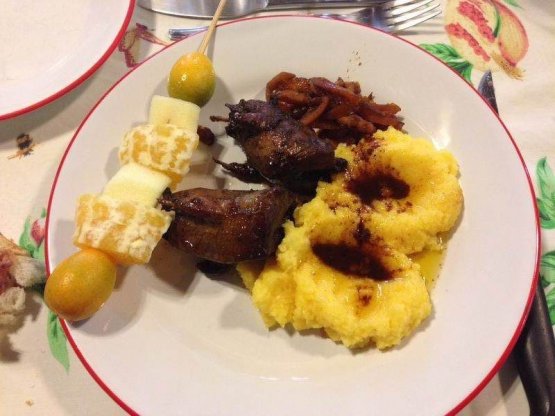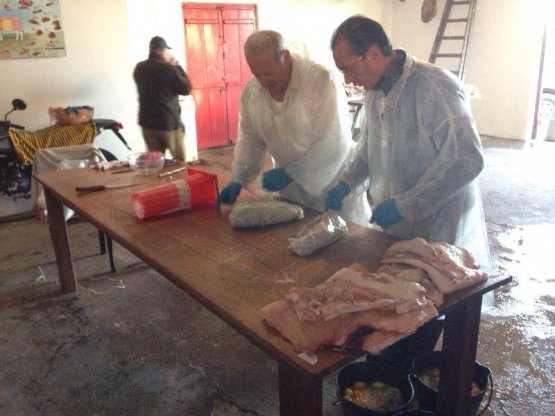Too bad for Mujica, Uruguay’s president, who professes vegetarianism in a country where one can eat the best meat in the world. His is certainly a respectable choice, still, whenever I can, I run away and visit my friends Luigi and Eva Olivieri – the gurises in the homonymous estancia in Sarandì Grande, in the region of Florida, 160 km North of Montevideo – I do so because I cannot resist the lure of the meat.
Let’s put dog-hunting aside (in an endless paradise full of partridges, woodcocks, hares, ducks, turtle doves and pigeons) and the way in which Eva – worthily sided by the very faithful Laura – sanctifies game on the table: a triumph of salmì, escabece, stews and gastronomic fantasies that only someone who has a sound background could afford (by the way, here the great chef-hunter Lucio Pompili is a regular and very appreciative client).

There’s also game: such as these splendid Turtle doves with polenta
Let’s put aside the still very famous jams, proudly self produced from the orchard-park of the
Olivieri family: a sumptuous explosion of colours that say
eat-me-eat-me, even if you are not as crazy for cakes as you are for savoury flavours. Let’s not think of vegetables, which are also very fresh, colourful and seasonal. Let’s pretend not to know about their taleggio and asiago cheese (the latter, matured one year, is grated on the pasta), nor of the butter made with fantastic milk. Nor the fragrance of the home baked bread. In other words, let’s put everything aside and just focus on the meat.
With all due respect to the president: let’s all stand up and clap our hands! And then let’s remain silent while
Luigi speaks: he spent a lifetime importing cattle, from Eastern Europe, Spain and South America. Today he breeds excellent cattle for himself and for his friends – that is to say his clients – often in anti-economical conditions, because “pleasure comes at a price”.
Tell me about your cattle. How do the animals live? What age are they when you slaughter them? What do they eat?
They are basically divided into two categories:
novillo, that is to say the beef that lives up to the age of two, free, in the
pradera, and is then fed with corn during the last month of life, and veal for white meat. The latter are is cross of
Limousine and
Aberdeen Angus, that is exclusively fed with milk up to the age of 6 months. Each animal eats 40 l of milk per day, divided into two meals. Their weight, when alive, is 300 kg. Our
asado is made with these animals. Using their rump we prepare veal cutlets, veal in tuna sauce, chargrilled veal.

The two "clients-pork-transformers" at work: in four days they “transformed” 540 kg of pork meat
Well, here there’s no lack of space, so why not take advantage from it? My pigs are a cross of
Landrace and
Large white. Over a year they reach 300 kg and from their thighs we create prosciutti that go from 20 to 23 kg. Which are then matured for two years. We make
coppa,
pancetta, with the fillet of the pork rolled inside. It is now a custom for two hunters, who are clients of the agritourism but most of all friends and have been passionate and excellent pork-transformers for generations, to come here every year in June, that is to say the Italian December, and dedicate four days to the preparation of
luganega sausage, pancetta, first class salami,
finocchiona, head of pork salami,
lardo. And then there’s the
culaccia, that is to say the boneless prosciutto matured one to two years, depending on the weight, which ranges form 9 to 14 kg.
How about boars?
They’re only indigenous. We cook the male in the oven, ranging from 6 to 7 kg. We usually don’t let the male boars grow more than 25 kg. The females, instead, reach 45 to 60 kg and we use theme to make prosciutto, culaccia and salami by adding 25% pork fat.
I’m not expert, Your Honour, but I can witness that the prosciutto made with boar melts in your mouth.